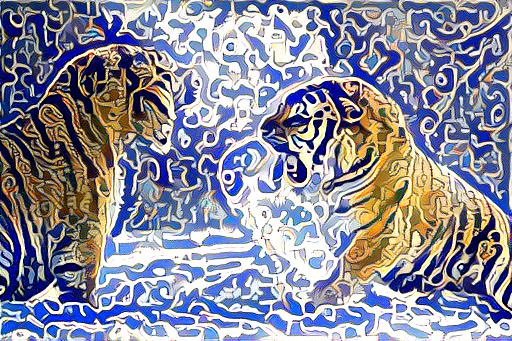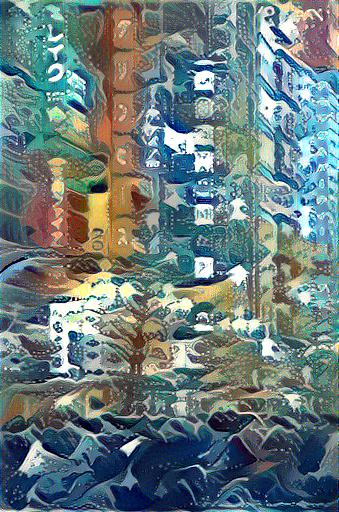This repository contains the code, slides and references for a 45 minute presentation delivered at the Bornhack 2019 conference.
This readme is meant as a one-stop shop for finding your way into the world of Machine Learning & Artificial Intelligence.
You may be entirely new to the worlds of data science, data engineering and software development. That's ok, you're in the right place. This document's job is to direct you to the right resources such as:
- MOOC courses
- techniques, algorithms & libraries
- tools, books, articles
and even organizations, events and groups of like-minded people within the world of ML that may be of interest to you, depending on which branch of ML / AI caught your eye.
We'll also showcase the code and core concepts for neural style transfer in a separate jupyter notebook, the end results will look like this (and you'll be able to run it on your own images to play around with it!):
| Original Image | Restyled Image | Style Sample |
|---|---|---|
 |
 |
 |
 |
 |
 |
 |
 |
 |
You can either simply read about the resources in the next section and follow any that pique your interest or you can install the requirements from the requirements.txt file present in this repository and follow along the code part of this presentation in a jupyter notebook or jupyter lab.
I recommend doing that in a separate virtual environment, created by installing the virtualenv module first:
pip install virtualenv
Followed by the creation of your own virutal environment for this repository:
python3 -m venv /path/to/your/virtual/environment
You can then activate this virtual environment on Mac and Linux (recommended) via:
source <venv>/bin/activate
And on Windows through:
<venv>\Scripts\activate
You can also accomplish the same clarity of dependencies with e.g. conda, if you prefer.
Finally, to install the exact versions of the required libraries:
pip install -r requirements.txt
conda install --file requirements.txt
You will need python version 3.7.0, as indicated by the badge on top of this readme file. You can check your python version through:
python --version
The last thing you'll need are the weights for the vgg network, which can be downloaded from here, and then need to be placed in the data/vgg_weights directory.
You're all set!
Here, you can find resources grouped by branches of ML.
- How do machines learn? - a cutesy, introductory youtube video by CGP Grey, albeit more focusing on genetic algorithms.
- Matrix Multiplication - a simple, step by step introduction to matmul by the Khan Academy.
- Convolution basics, an interactive demonstration of how a convolutional layer transforms an image, by Victor Powell.
- Backpropagation, i.e. what makes learning possible, very nicely explained visually here.
- Nonlinear Activation Functions a good overview of what they are and why they are needed, by Dishashree Gupta.
- Recurrent Neural Networks a concise & elegant explanation of RNNs (particularly focusing on LSTMs - Long Short Term Memory layers) by Chris Olah.
- Transfer Learning - an article explaining transfer learning in convolutional neural networks in PyTorch by Will Koehrsen.
At some point, you'll want to jump in-depth into one of the popular ML libraries:
- Keras library is the high-level api of Tensorflow. It is perhaps the easiest library towards starting to train your models. Here's the introduction and documentation for it. Created by Francois Chollet.
- PyTorch is the main competing library of Tensorflow, favored in the latest version of the FastAi online course. Here's a page with setup and docs.
- TensorFlow is Google's library for machine learning & deep learning, currently in version 2.0 - here's its official page with installation instructions and tutorials.
- Switching from TensorFlow to PyTorch - an article on medium by Rahul Agarwal, that can give you a sense of the differences between the two libraries.
- FastAi Library - effectively a high-level api for PyTorch but also something significantly more than that. You can find the docs and installation guide here.
- XGBoost library, implementing the gradient boosting framework, which has been very popular with regards to Kaggle challenges, it's docs can be found here.
- ONNX is a tool for converting models developed through various libraries into interchangeable formats. If you train in PyTorch but want to use Tensorflow Serving, use ONNX.
- Lime is a project aimed to help us understand why our models make the predictions they make - what in the input particularly influences the output. Very useful in classification tasks, helped me diagnose my preprocessing pipeline in many NLP tasks. Also great for the visualizations it provides.
There are other libraries that you may find useful - such as numpy, pandas, and sklearn. If you're not using Python, you may be interested in languages such as R and Julia, and their relevant ML libraries.
A key problem in ML is transparency of the models. Here are some tools and articles that will help you both understand and then explain your models.
- Simple Network Training in the Browser - can be done and played around with here, helpful in building initial intuitions about what's happening during learning, with a beautiful and elegant visualization.
- Convolutional Layers
- Simple, interactive visualization in 3D and 2D of convolutional, pooling and dense layers. It also shows how 2 convolutional layers are connected.
- Great medium article by Fabio M. Graetz on how to visualize your convolutional layers.
- Fantastic, in-depth but easy to follow along article by Chris Colah.
- Activation Atlas
- Gorgeous feature visualization atlas for the entire InceptionV1 network, revealing how a network represents larger visual concepts, by Shan Carter, Zan Armstrong et. al.
Models that can generate new samples, similar to the ones they were exposed to, such as images, video, text or music.
- Generative Adversarial Networks - a great introduction to the concept, including code and links to many other related technologies, by Skymind.
- Music Generation - a MuseNet paper by OpenAi regarding the generation of short musical samples.
How to train models on the devices, due to privacy concerns.
- Federated Learning Protocol - an article explaining the concept and protocol by Adrian Colyer.
Software agents that act in an environment to maximize a reward function.
- Best Hands-On Introductory Tutorial to RL by the OpenAi team, called SpinningUp. Includes a detailed but approachable introduction to all the relevant concepts, solid instructions on environment setup and specific examples of how to get started and run actual RL algorithms locally.
- Unity's Environment Tool for training RL agents in a way that's easy to visualize, here.
- DeepMind's AlphaStar, which is the model that plays Starcraft 2, a nice overview of how it works.
Working with understanding & generating text, translation & language models.
- OpenAi's Generative Language Model - which can spin up stories about unicorns, here.
- NLP Preprocessing - my own article on medium.
The core of the provided jupyter notebook and python script. Uses a pretrained network for visual classification in a very interesting way.
- Neural Style Transfer
- General introduction by Jeremy Howard's Fastai, youtube lecture 13.
- Introductory articles by Vamshik Shetty and Pawan Sasanka Ammanamanchi, part 1 on medium.
- Transferring style in 3D, article by Daniel Sýkora, Ondřej Jamriška et al., short youtube introduction by Two Minute Papers.
Speculative thoughts about a model that can generalize to many tasks, on a level comparable to human intelligence. Treat these with a grain of salt and more as an exercise in stretching the mind.
- Orthogonality Thesis - an article regarding the possibility of any level of intelligence coinciding with any set of goals, by LessWrong's Eliezer Yudkovsky.
- Nick Bostrom's Superintelligence book, attempting to approach the idea of many types of enhanced intelligent agents and their consequences.
- AI Boxing Problem - and a game concept about how even an oracle AI could be difficult to contain, as long as it can communicate with a person.
- Universal Paperclip Maker - a conceptual browser clicker game with some interesting undertones, playable here.
- Youtube Channels about ML, Deep Learning, Artificial intelligence:
- Wonderful channel by Rob Miles, with a strong focus on long-term artificial general intelligence, but also explaining recent papers within the field of ML in some depth.
- Bite-sized introductions to recent ML (& much more) papers by Two Minute Papers.
- Great, foundational channel devoted to the Fastai course by Jeremy Howard.
- Siraj Raval's channel about libraries in ML, new papers and even the business side of working as an ML engineer. Personally a bit too flashy for my taste, but perhaps it will be just the thing for you :).
- Honorable mentions: Tom Scott's video about a specific AGI scenario, and Primer's channel dedicated to running simulations to explain complex concepts in clearer ways.
- For more youtube outlets, check out this list.
- Fantastic, in-depth but easy to follow articles by Chris Colah on his blog.
- Distil - a wonderful source for high-quality, well-visualized ML articles.
- Acolyer - a blog with daily articles about ML, math, programming and more by Adrian Colyer.
You can also find plenty of interesting articles on medium and towardsdatascience.
Many interesting papers are published on arxiv before they are published in a journal or conference. I personally recommend reading articles explaining the gist of the paper first, then the abstract and summary of the article instead of jumping straight in. Below are some examples of interesting papers.
- Attentional Generative Adversarial Networks - here's a paper on how to teach a model to generate an image based on sentences describing its content.
- Concrete Problems in AI Safety - a great paper proposing a set of safety scenarios that should be passed by the AI agent, available here.
There are so many it's hard to pick the most interesting ones, primarily be aware of the existence of arxiv and at some point consider reading and reimplementing the papers. There are good tools for managing the scientific papers such as zotero and mendeley.
These are the foundational (but still quite in-depth) courses that you can take online if you're considering a career in ML.
- Andrew Ng's Introductory Stanford ML Course available on Coursera. It includes a strong introduction to linear algebra and classically used algorithms for regression and classification. There's an option to take the paid version of the course and receive a linkedin certification. This was once considered to be the obligatory starting point for a career in ML. Has a very bottom-to-top approach, starting with an in-depth understanding of the underlying mathematical concepts.
- Jeremy Howard's FastAi Course - in my opinion the absolute best course available for quickly getting to a point where you can do meaningful work in the field. Has the opposite approach to the previous course, prefering to learn concepts (still very much in depth) by doing, top-down. It requires a lot of work and the setup of the environment can be challenging, but the skills gained by recreating the notebooks from this course are priceless. Study groups following this course together have recently become popular and they're a great way to stay motivated.
- Selection of Specialized Deep Learning Courses, available here, at least partially created by Andrew Ng.
- European Commission's Guidelines on Ethical Ai, that promotes trustworthiness, can be found here.
- Meetups - you may want to look up the PyData, DataViz, Computer Vision and other groups of interest in your area. Having people to share your work with and learn from them is a great way to expand one's understanding. I also recommend finding study groups for doing the online courses outlined in the previous sections.
Jump into the references from above, share your experiences with the wider ML / AI community, make things that work and have fun :).
The presentation's core is the neural style transfer code, heavily borrowed from Pawan Sasanka Ammanamanchi's (Shashi456@github) repository implementing the paper "A Neural Algorithm of Artistic Style" by Leon A. Gatys, Alexander S. Ecker and Matthias Bethge, available on arxiv here. Pawan's implementation can be found here and his 6 part tutorial on neural style transfer, co-authored with Vamshik Shetty can be found here. The original paper, the re-implementations and the articles are all fantastic.
Contributions are always welcome!
If you find an error, a better reference point for the branch of ML, an updated version of a linked tool or such - please reach out via email at the address given in my github bio or propose a fix by opening a pull request.
To the extent possible under law, the author has waived all copyright and related or neighboring rights to this work.






